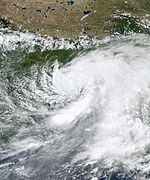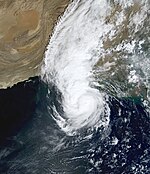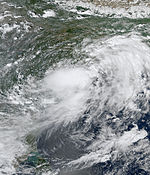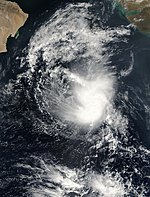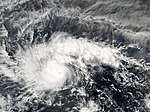2004 North Indian Ocean cyclone season
| 2004 North Indian Ocean cyclone season |

Season summary map
|
| Seasonal boundaries |
| First system formed |
May 5, 2004 |
| Last system dissipated |
December 2, 2004 |
| Strongest storm |
|
| Name |
BOB 01 |
| • Maximum winds |
165 km/h (105 mph)
(3-minute sustained) |
| • Lowest pressure |
952 hPa (mbar) |
| Seasonal statistics |
| Depressions |
10 |
| Deep depressions |
7 |
| Cyclonic storms |
4 |
| Severe cyclonic storms |
3 |
| Very severe cyclonic storms |
1 |
| Total fatalities |
587 total |
| Total damage |
$129.8 million (2004 USD) |
| Related articles |
|
|
North Indian Ocean tropical cyclone seasons
2002, 2003, 2004, 2005, 2006
|
| Severe cyclonic storm (IMD) |
| Tropical storm (SSHWS) |
|
|
| Duration |
May 5 – May 10 |
| Peak intensity |
100 km/h (65 mph) (3-min) 989 hPa (mbar) |
| Extremely severe cyclonic storm (IMD) |
| Category 1 tropical cyclone (SSHWS) |
|
|
| Duration |
May 16 – May 19 |
| Peak intensity |
165 km/h (105 mph) (3-min) 952 hPa (mbar) |
| Depression (IMD) |
|
|
| Duration |
September 12 – September 15 |
| Peak intensity |
45 km/h (30 mph) (3-min) 996 hPa (mbar) |
| Severe cyclonic storm (IMD) |
| Tropical storm (SSHWS) |
|
|
| Duration |
September 30 – October 10 |
| Peak intensity |
100 km/h (65 mph) (3-min) 990 hPa (mbar) |
| Depression (IMD) |
|
|
| Duration |
October 2 – October 8 |
| Peak intensity |
45 km/h (30 mph) (3-min) 1002 hPa (mbar) |
| Deep depression (IMD) |
| Tropical storm (SSHWS) |
|
|
| Duration |
November 2 – November 7 |
| Peak intensity |
55 km/h (35 mph) (3-min) 1004 hPa (mbar) |
| Severe cyclonic storm (IMD) |
| Category 1 tropical cyclone (SSHWS) |
|
|
| Duration |
November 27 – December 4 |
| Peak intensity |
100 km/h (65 mph) (3-min) 994 hPa (mbar) |
The 2004 North Indian Ocean cyclone season was the first in which tropical cyclones were officially named in the basin. Cyclone Onil, which struck Pakistan, was named in late September. One other storm, Cyclone Agni, was also named, which crossed into the southern hemisphere during its origins and became one of the storms closest to the equator. The season was fairly active, with ten depressions forming from May to November. The India Meteorological Department designated four of these as cyclonic storms, which have maximum sustained winds of at least 65 km/h (40 mph) averaged over three minutes. The Joint Typhoon Warning Center also issued warnings for five of the storms on an unofficial basis.
In early May, two tropical storms formed on opposite sides of India. The first formed on May 5 and meandered while intensifying, dropping 1,840 mm (72 in) in Aminidivi in the Lakshadweep group offshore western India, which was the highest daily rainfall total in the basin. A week later, a cyclone – the strongest of the season – struck Myanmar, killing 236 people and leaving 25,000 people homeless. Depressions also formed on opposite sides of India in June. A depression in September killed 59 people after dropping torrential rainfall over Bangladesh and adjacent West Bengal. In October, another depression struck the region, killing 273 people. There was also a short-lived cyclonic storm in the Arabian Sea in November.
...
Wikipedia






